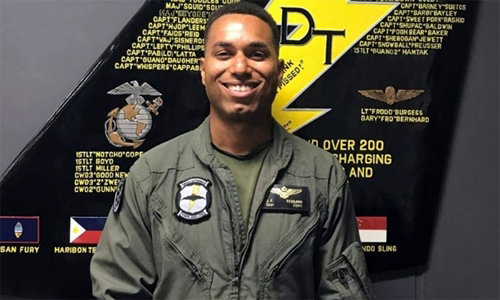Data from the watch shows that Captain Jahmar Resilard struggled at sea nearly 10 hours before drowning after an accident last year.
"The data from the smartwatch shows that Captain Jahmar Resilard's heart still beats 86 beats per minute when the pilot launches a parachute from the fighter at 1:44 am on December 6 until 11:30 (9 hours 46 minutes), in sea level of 20 degrees C ", the US military concluded in the investigation report published yesterday.

Captain Jahmar Resilard, F / A-18D pilot killed after collision with KC-130J refueling offshore Japan in December 2018 Photo: US Marine
Captain Resilard was one of six people killed in the collision between the pilot F / A-18D and the KC-130J tanker in December 2018 off Iwakuni, Japan.
The accident occurred when two U.S. Marines planes were conducting routine training on December 6, 2018, after taking off from Iwakuni air base in southern Japan. In the KC-130 there were 5 people, while on the F / A-18 fighter there was Captain Resilard and a weapons officer. All five people on the KC-130J tanker were killed.
After the collision, Resilard and the weapons control officer both parachute and fall into the sea. However, the weapons control officer was able to spread his life and was rescued by SH-60 helicopter of the Japanese army 4 hours later. This person said that he must constantly slap water from a life raft while waiting for rescue forces to arrive.
It was only at 12:22 am on December 7, 2018, that Resilard's body was found and boarded by the Japan Maritime Self-Defense Force, almost an hour after the pilot's heart stopped beating. Resilard heart rate data is saved on the Garmin Fenix 3 smartwatch he wears on his wrist.
Autopsy reports show that there are many cuts and bruises on Resilard's body. The pilot suffered a head injury and most likely drowned. Investigators noted that Resilard and the weapons control officer on the F / A-18D were not wearing anti-heat gear to help maintain life in case of cold water.
Investigators also pointed out that the US Marine Corps 12 at Iwakuni Air Base, Japan, had no capacity to search and rescue. Japanese forces can deploy search and rescue operations 15 minutes after receiving notice if they are not on duty. If Japanese forces are busy, the time to respond to rescue requests can be up to two hours.
The four Marine Corps 242 officers, including the commander, the executive officer, the combat officer and the flight safety officer were fired after the incident. Investigators also uncovered a series of irregularities in the unit, such as an officer using indiscriminate and overdose prescription drugs, including two people involved in a fatal accident.
Investigators recommended the 1st Marine Corps to organize annual search and rescue training with Japan and set up a task force at Iwakuni Air Base.
Major Brian Block, spokesman for the III Expeditionary Unit based in Japan, said on November 14 that the 1st Marine Corps organized a search and rescue operation with the Japanese Self-Defense Force in May. 4 and there will be subsequent batches.



 SumbalJavaid
SumbalJavaid







